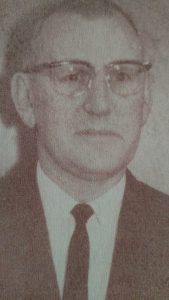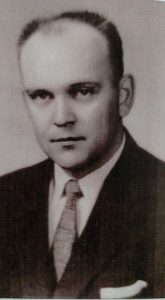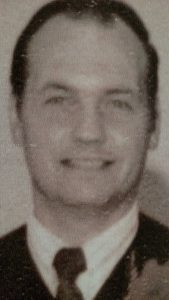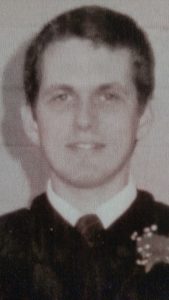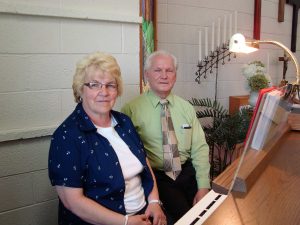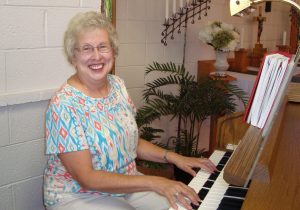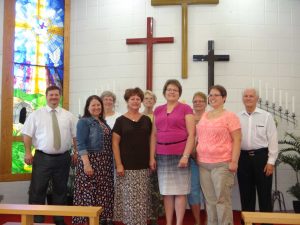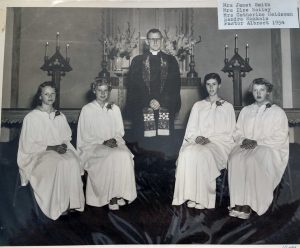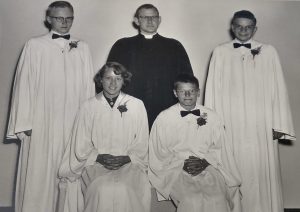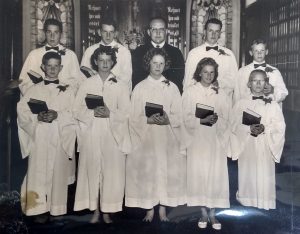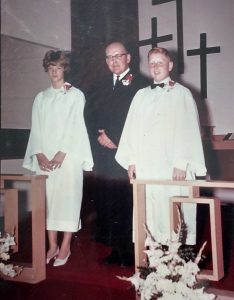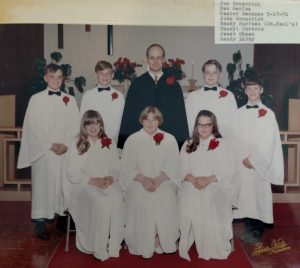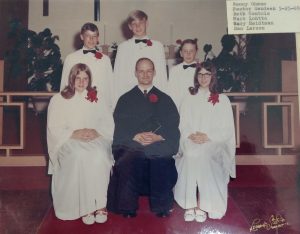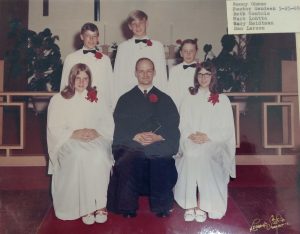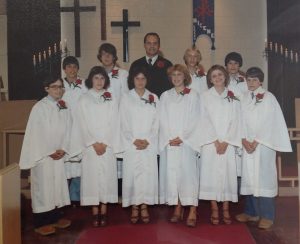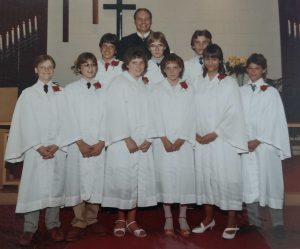Calvary Lutheran Church:
The history of Calvary Lutheran Church is a history closely connected with the formation of the church body to which it belongs, the Church of the Lutheran Confession (CLC). Calvary Lutheran Church was organized in April 1955 and is a charter member of the Church of the Lutheran Confession which incorporated in December of 1960.
Early History of Calvary Congregation — 1953-1955:
At one time some members of Calvary Lutheran Church attended either Trinity Lutheran Church or St. Paul’s Lutheran Church, and it was through these churches that they had come to be ministered to by Pastor William Roepke. He had accepted a call to both Trinity and St. Paul’s congregations in Marquette and Green Garden, Michigan in 1909 and served both until his resignation in January of 1953. Pastor Egbert Albrecht was called to serve both congregations after the retirement of Pastor Roepke and was installed at Trinity Lutheran Church, Marquette, on February 1st, 1953. As pastor of a segment of the Trinity and St. Paul’s congregations he helped in the organization of Calvary Lutheran Church later in 1955.
In 1951 the Evangelical Lutheran Synodical Conference of North America consisted of four Lutheran church bodies or synods: The Missouri Synod (est. 1847), the Wisconsin Synod (est. 1849), The Slovak Synod (est. 1902) and the Norwegian Synod (est. 1918). There were other large groups, namely the American Lutheran Conference and the National Lutheran Council. Trinity Lutheran Church of Marquette had been received into membership within the Wisconsin Synod in 1896, and St. Paul’s Lutheran even earlier, in 1890.
In the Annual reports (1953) of Trinity and St. Paul’s there was the important notation that fellowship between the Missouri Synod and the Wisconsin Synod was threatened because the Missouri Synod was involved in unionistic action.
The year 1955 was full of many troublesome disturbances. Details of incidents serve no good purpose, but a summary of some important events leading to happier times are significant. These events were to lead to the organization of Calvary congregation on the one hand, and to the termination of a seventy-three year old relationship between St. Paul’s and Trinity congregations on the other. The serious problems for Trinity Congregation with regard to such matters as signing the Roman Catholic antenuptual agreement, Masonic lodgery, the Scout movement, prayer fellowship, the Military Chaplainscy, attacks on Genesis 1 and 2, and denial of the inerrancy of Holy Scripture, were complicated when Pastor Albrecht met with determined opposition in his efforts to correct and admonish those in error. In March of 1955, a special meeting of Trinity ended with some far-reaching action being taken. The Council voted to terminate Pastor Albrecht’s call and Trinity Lutheran Church declared itself withdrawn from the Wisconsin Synod.
Early Activities of Calvary Lutheran Church — 1955-1957:
After the March 1955 action taken by the Trinity Council, those members from Trinity who still wanted to be served by Pastor Albrecht called themselves the Synodical Conference Lutherans, for the time being. Then beginning on April 17, 1955, the Marquette group began meeting at the Seventh Day Adventist Church. On that evening an organizational meeting of the new Wisconsin Synod Mission was held for the purpose of adopting a constitution, choosing a name fro the congregation, electing a church council and transacting other necessary business. Suggested names for the new congregation had been given out previous to the meeting and three names were to be indicated by every communicant member. Names came under four headings: The Godhead, Biblical Places, Saints, and Christian names. Members chose the name Calvary Lutheran Church. Nine men who served as members of Calvary’s first church council were elected as follows: Three years — Joseph Gauthier, Alvin Wendt, Warren Contois. Two years: Harold Herlich, Jr., Herbert Maves, Fred Klumb. One Year: Wm. Fassbender, Harold Libby, Herold Herlich, Sr. Sunday School Superintendent: Maurice Libby.
In June of 1955, St. Paul’s concluded their affiliation with Trinity, and Pastor Albrecht and his family moved out of the old parsonage and moved into the parsonage at Green Garden where they spent the summer months. In September of 1955 they moved into Calvary’s newly acquired parsonage at 347 E. Arch Street, in Marquette. In the meantime, both congregations concerned themselves with the August synodical convention of the Wisconsin Evangelical Lutheran Synod and discussed the deteriorating relationships between it and the Missouri Synod.
In October of 1955, Calvary purchased five lots on the corner of Sixth and Ohio streets and formed a Building Committee.
In November of 1955 the Women of Calvary organized and adopted a constitution and chose their first officers: President – Miss Edna Fassbender, Vice President — Mrs. Harold Herlich, Jr., Secretary — Mrs. Robert Surfas and a Treasurer, Mrs. Herbert Maves.
The first marriage to take place in the fellowship of the new congregation was between George Gregorich and Eunice Gauthier on July 2, 1955. The first child to be baptized was Nancy Karen Ohman on July 17, 1955. The first children confirmed on July 17, 1955 included Hazel Antcliff, Jack Libick, William Dorow and Michael McCarty.
In 1956, Calvary worked toward building a house of worship on their new property. The building committee, made up of Chairman – Fred Klumb, Harold Libby, Emmet Wendorf, Russel Zerbel, Robert Serfas and others, called many meetings. The high cost of building forced the congregation to consider building a church or a different type of building which could be used for a Christian Day School.
In August of 1956 the Wisconsin Synod met in convention and decided to retain fellowship with the Lutheran Church Missouri Synod under a ‘vigorously protesting fellowship’ which meant fellowship only with those who did not persistently uphold the offenses.
In April of 1957, Pastor Albrecht received and accepted a call to serve two congregations both named St. Paul’s. The one was located in Marquette Wisconsin and the other in Manchester. After Pastor Albrecht moved the congregation called Pastor Bertram Naumann who accepted the call. On July 14, 1957, Pastor Naumann was ordained and installed to serve both St. Paul’s and Calvary.
On October 21st the Congregational Meeting was the first to take place in the solid new church. In the spring of 1958 the first wedding took place in the new church building with the marriage of Bernard Currie and Dorothy Dorow in April. The next day the first child baptized at Calvary Church was Cynthia Klumb.
Throughout the year 1958 synodical matters were thoroughly studied and discussed by every possible means. Members were selected to assist the pastor on Union matters and as the year wore on discussion centered around a declaration protesting fellowship with the Wisconsin Synod which had been initiated by a number of pastors in the Lake Superior Conference. The Lake Superior Pastoral Conference unanimously adopted and sent, to the Northern Wisconsin District Convention at Appleton in June, a memorial recommending the Wisconsin Synod reconvene to reconsider intersynodical relations. The District refused to recommend any final action on the long standing doctrinal controversy with the Lutheran Church Missouri Synod.
The year 1959 proved to be a year of decision for Calvary and St. Paul’s congregations with regard to fellowship relations with the Wisconsin Synod. Two members of Calvary congregation, Frank Paull, Jr. and Alvin Wendt were co-delegates at the Biennial Convention held in August in Saginaw, Michigan. The Wisconsin Synod repudiated those who had signed the memorial and voted to continue discussion of the disagreements with the church bodies of the Synodical Conference. In October 1959 St. Paul’s and Calvary’s Councils recommended that they suspend fellowship relations with the WELS and the Synodical Conference. The Lutheran Spokesman, a publication which first appeared in June 1958, voiced the important consensus of those congregations that had left the Wisconsin Synod. During 1959 a conference at Red Wing, Minnesota appointed a committee to define the basis of fellowship in the confession of those meeting together and sought to organize to some degree. A constitution committee filed a proposed constitution of this Interim Conference.
The Church of the Lutheran Confession — 1960-1963:
In August 1960, Pator Naumann and Russel Zerbel attended the organization meeting held in Watertown, South Dakota, where Pastor M.J. Witt of Spokane, Washington acted as temporary Chairman and Pastor Paul F. Nolting of Sleepy Eye, Minnesota acted as secretary. At this meeting the conference chose the name Church of the Lutheran Confession (CLC). Pastor Albrecht served on the Mission Committee and Pastor B.J. Naumann served on both the Church-Ministry Committee and the Equalization Committee.
In January of 1961, Pastor Naumann and Delegate Warren Contois attended the final organizational conference of the Church of the Lutheran Confession at Sleepy Eye, Minnesota. The names of 33 congregations were read and received as Charter members. Both Calvary and St. Paul’s were read into that record. The Ecumenical Movement had been gaining momentum and popularity in attempts to realize ‘unity of spirit’ through joint services and fellowship in spite of the prevailing differences of tenets and practices. This was one of the reasons the conference at Sleepy Eye moved to publish another official organ of the church, The Journal of Theology.
It was announced that Miss Zaiga Barnaks, who had so faithfully served as organist would be leaving. The Lord provided for the filling of this vacancy by a young girl named Bonnie Maves. She served faithfully for the next eight years.
In 1963, Calvary Lutheran Church hosted the Convention of the Church of the Lutheran Confession. Another special note appeared in the church bulletin early in the year 1963 stating that the CLC had passed a resolution that the Ingram Estate of Eau Claire, Wisconsin be purchased and the effects of Immanuel Lutheran College be moved from Mankato including the effects of the professors involved. This 75-acre tract together with the buildings would serve the immediate needs of the educational institution of our congregations and permit future development of them.
The 1963 CLC Convention was followed by a celebration of 100 Years of Grace by St. Paul’s congregation, and Calvary joined with her sister congregation in this joyous occasion.
In June of 1964 a decision was made and plans worked out in order to proved a temporary, part-time call to another minister. The call was extended to Paul. G. Fleischer to become Assistant Pastor of Calvary and St. Paul’s congregations. He moved with his family to Marquette the first week of July, 1964. He was a recent graduate of ILC and Seminary at Eau Claire and his welcome was arranged by both congregations. To further the work at hand and to aid the pastors, Calvary also proposed a change in its constitution to allow for a Board of Elders.
In 1965 the idea of dividing the joint parish into separate congregations, each with its own pastor, gathered steam. So it was for the first time in over 100 years, St. Paul’s called its own pastor and this joyous occasion brought Professor Egbert Schaller of Immanuel Lutheran Seminary in Eau Clarie and Pastor Egbert Albrecht from Wisconsin as Conference Visitor to install Pastor Naumann at Calvary and Pastor Fleischer at St. Paul’s. A milestone in the history of conservative Lutheranism in the Marquette area had been reached by the two congregations and they could now make fuller use of the Gospel of Christ. later in the year St. Paul’s would dedicate a new parsonage as well.
In August of 1965 the 6th Annual Convention of the Church of the Lutheran Confession was held at Eau Claire, Wisconsin with Harold Magadanz attending as delegate with Pastor Naumann, notice was taken of the historic changes which had come to pass at Green Garden and Marquette. It had been five years ago that this original group had united under the name of Church of the Lutheran Confession. With the work of various committees and boards going forward in an orderly fashion the CLC had designated five Conference groups, namely: Wisconsin, West Central, Pacific, Michigan and Minnesota. Locally there were three students at ILC from the area — Mary Grimes, Walter Priebe, and Bonita Gutzman.
Servants of the Word
Pastor Egbert Albrecht served from 1955 until 1957; Pastor Bertram Naumann served from 1957 until 1966; Pastor Paul Fleischer served as Assistant Pastor from 1964-65; Pastor James Sandeen served from 1967 until 1974; Pastor Walter Schaller served from 1974 until 1987. Pastor David Sweet served from 1986 until 1989; Pastor David Reim served from 1989 until 1997; Pastor Joel Fleischer served from 1997 until 2014. Pastor Andrew Schaller served from 2015-2023.
Worship Leaders
In the History of Calvary Lutheran many different individuals have lent their God-given talents to lead worship services. They have included the following: Zaiga Barnaks, Mrs. Edna Reader, Mr. Frank Paull, Mrs. Julie Reim, Mrs. Beth Fleischer, Mr. Walter Priebe and Mrs. Cheryl Houle currently serve as the church organists.
Calvary Confirmation Classes
In the History of Calvary Lutheran there have been many different Confirmation Classes.

